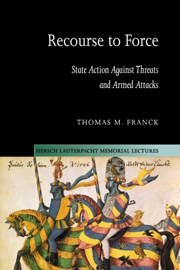Book contents
- Frontmatter
- Contents
- Acknowledgments
- 1 The United Nations' capacity for adapting to radical changes of circumstance
- 2 Use of force by the United Nations
- 3 The original parameters of self-defense
- 4 Self-defence against state-sponsored terrorists and infiltrators
- 5 Self-defense against ideological subversion
- 6 Self-defense against attacks on citizens abroad
- 7 Anticipatory self-defense
- 8 Countermeasures and self-help
- 9 The “purely humanitarian” intervention
- 10 What, eat the cabin boy? Uses of force that are illegal but justifiable
- Index
4 - Self-defence against state-sponsored terrorists and infiltrators
Published online by Cambridge University Press: 17 July 2009
- Frontmatter
- Contents
- Acknowledgments
- 1 The United Nations' capacity for adapting to radical changes of circumstance
- 2 Use of force by the United Nations
- 3 The original parameters of self-defense
- 4 Self-defence against state-sponsored terrorists and infiltrators
- 5 Self-defense against ideological subversion
- 6 Self-defense against attacks on citizens abroad
- 7 Anticipatory self-defense
- 8 Countermeasures and self-help
- 9 The “purely humanitarian” intervention
- 10 What, eat the cabin boy? Uses of force that are illegal but justifiable
- Index
Summary
In December 1965, the General Assembly, without opposition, declared that “subversion and all forms of indirect intervention constitute a violation of the Charter of the United Nations” and can lead “to the creation of situations which threaten international peace and security.” By thus linking subversion and indirect intervention to a “threat to international peace and security” which the Charter text (Article 39) brackets with “aggression,” the Assembly may be seen to accept that the victims of such intervention are entitled to be the beneficiaries of Chapter VII collective measures ordained by the Security Council. It could also be argued that a state whose “peace and security” has been threatened might justifiably resort to the same use of force in “individual or collective self-defence,” as is permitted victims of armed attack by Article 51 of the Charter.
This modification of the strict literal text of Charter Articles 2(4) and 51 has been further expanded in the Assembly's 1974 Resolution, which stipulates:
The actions of a State in allowing its territory, which has been placed at the disposal of another State, to be used by that other State for perpetrating an act of aggression against a third State;
The sending by or on behalf of a State of armed bands, groups, irregulars or mercenaries, which carry out acts of armed force against another State of such gravity as to the acts listed above, or its substantial involvement therein … shall … qualify as an act of aggression …
This, in fact, seemed to be the principle implemented after the terrorist attack on the World Trade Center on September 11, 2001.
- Type
- Chapter
- Information
- Recourse to ForceState Action against Threats and Armed Attacks, pp. 53 - 68Publisher: Cambridge University PressPrint publication year: 2002
- 1
- Cited by



